Growing oyster mushrooms at home
Growing mushrooms at home allows you to pamper yourself with this tasty and healthy product all year round, and can also become an excellent source of additional income. Oyster mushrooms are one of the simplest types of mushrooms of their kind. Anyone who has decided to try their hand at mushroom growing can feel like a master growing oyster mushrooms. This variety is very unpretentious and does not require special care. Where is the best place to grow oyster mushrooms at home and what is needed for this? Let's try to figure it out!
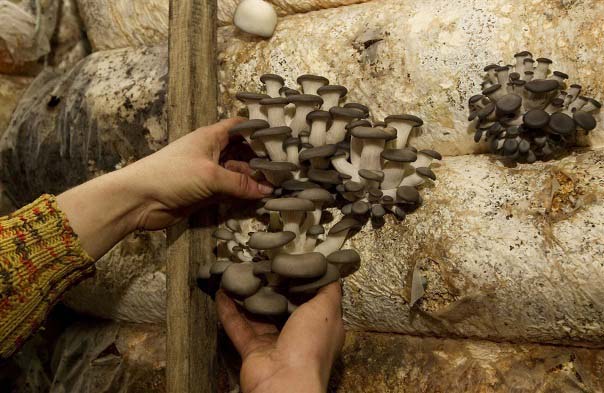
Content
Features of growing oyster mushrooms: necessary conditions and premises
Oyster mushrooms or oyster mushrooms are a unique species that can sprout on any soil, be it dry grass, thyrsa, coffee grounds or even cotton cloth. This low-growing plant is able to extract nutrients from everything in its environment. Another advantage of the species is its fast growth rate.Within two weeks after sowing, the first crop can be harvested.
Growing oyster mushrooms does not require any special knowledge and skills. The best place for growing oyster mushrooms will be the basement or cellar of a private house. Oyster mushrooms are not thermophilic and do not need a lot of light. If you don't have a basement, they can be grown in a greenhouse in a country house or shed. Despite the simplicity and the absence of excessive maintenance of mushrooms, the growing room must be properly prepared.
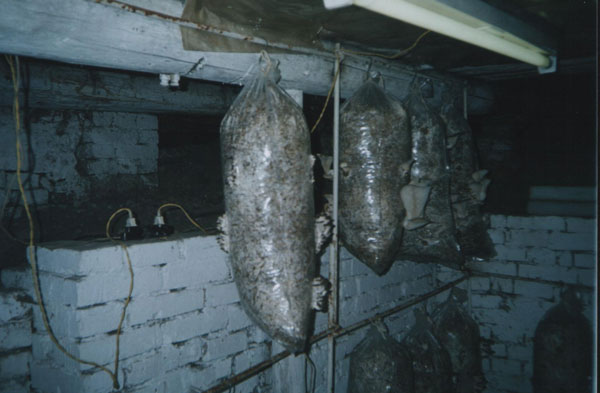
The following equipment should be installed in the room and special conditions for growing oyster mushrooms should be created:
- Growing equipment (bags). The choice of equipment depends on the method of growing oyster mushrooms. The most convenient and economical option is bag growing. To do this, you need special supports with hangers on which the bags with the substrate are suspended. It is best to use plastic equipment, it does not corrode and is much cheaper. By the way, oyster mushrooms can also be grown on stumps.
- Room temperature. This mushroom does not need high temperatures, so there is no need to create a greenhouse. It will be enough to insulate the room and carry out thermal insulation to retain moisture. Naturally, elementary heating devices must be present so that the temperature does not fall below 13 ° C. An elevated temperature is necessary only at the initial stage after planting the mycelium (22 ° C - 25 ° C). Infrared lamps can be used for additional heating.
- Humidity. Oyster mushrooms are very fond of moisture, so the air in the growing room must be constantly humidified. It is very easy to do this using nebulizers or special electronic humidifiers. The humidity level should be around 70-90%.
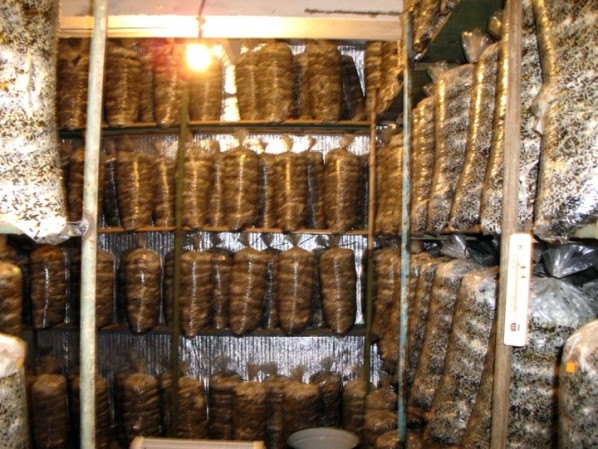
- Ventilation and lighting. All mushrooms grow in the fresh air and oyster mushrooms are no exception. The room must be systematically ventilated. This can be done manually, or you can install special hoods that will deliver fresh air. Again, purchasing such equipment is expensive, so unless you plan to grow large quantities of oyster mushrooms for sale, it won't be cost effective. When it comes to lighting, you need to install daylight garden lamps. You won't need a lot of them, since this type of mushroom does not require a lot of light.
- Cleanliness and pest free. To grow a large, and most importantly, a healthy crop, the premises must be clean. If the basement is heated by groundwater, and there is fungus or bloom on the walls, this can seriously affect the yield. Mushrooms will hurt, light spots will appear on them, mushrooms will lose their density, become soft. To protect future plantings, it is necessary to disinfect the premises. First, they thoroughly clean the walls, ceiling and floor, remove all dirt and mold. Then, all surfaces are sprayed with a solution of sulfate, and the walls and ceiling are covered with a solution of lime and copper sulfate.
Video: room for growing oyster mushrooms in the basement
Note! If there is fungus in the room, it is better not to use it as a greenhouse. High humidity, which is necessary for growing mushrooms, will only aggravate the situation, the disease will affect crops, they will become inedible and poisonous.
How to grow oyster mushrooms at home: growing technology
Having decided on the location of the mushroom greenhouse, after thoroughly disinfecting the premises and installing the necessary equipment, you can proceed to the very process of growing mushrooms. The technology of growing oyster mushrooms involves several stages.
Video: step-by-step instructions for breeding oyster mushrooms at home
Substrate preparation
The key to a rich harvest is a high-quality substrate. Although it is generally believed that oyster mushrooms are indiscriminate in this regard, the soil should still be fertile.
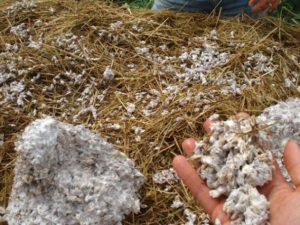
The best substrate for breeding oyster mushrooms are:
- dry straw of wheat, barley and buckwheat;
- hardwood sawdust;
- the husk of sunflower seeds;
- dried stalks and ears of corn.
Select the amount of substrate according to the amount of mushrooms you want to grow. So, one bag for growing oyster mushrooms is designed for 5 kg of substrate. All components of the substrate must be clean and dry, they must not have mold or rot, and they must not be rotten. It is best to disinfect the selected substrate by heat treatment. Next, you need to grind these components to a fraction of 4-5 cm and mix. Repeated heat treatment for two hours and squeeze out.
Actually, the substrate for growing oyster mushrooms is ready.
Selection and purchase of mycelium
For growing oyster mushrooms at home, it is best to use grain mycelium. It is very convenient to sow and does not require additional processing.
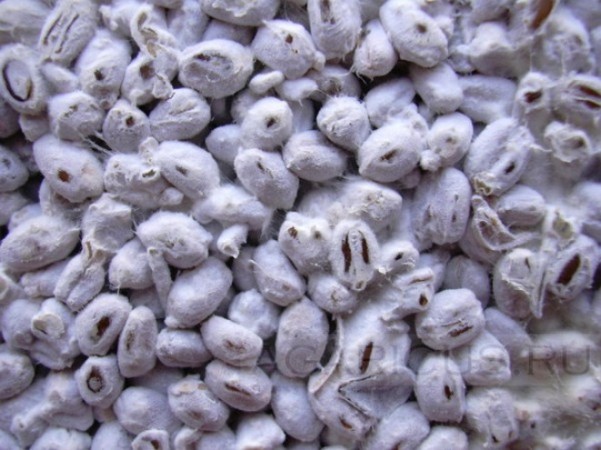
When buying mycelium, pay attention to its appearance. The grains should be yellow with a slight orange tint. It is strictly forbidden to buy mycelium on which dark spots are visible - this is the first indication of the presence of mold. You can also determine the quality of the planting material by smell, it must be fresh and smell like mushrooms. If you smell a slight ammonia smell, it means that the mycelium was stored incorrectly and deteriorated.
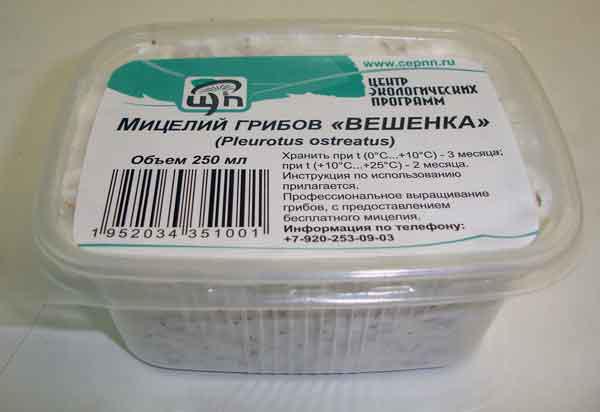
Be sure to pay attention to the manufacturer's company, it is better if it is a well-known and large manufacturer in the seed market, read reviews of gardeners on the Internet. Do not buy large quantities of mycelium at once, take a trial batch. If the mycelium germinates without problems, forms good and healthy myceliums, you can purchase a large batch.
If you want to make your own oyster mushroom mycelium, then read this article.
Landing
Before proceeding with planting, the mycelium must be placed in a room where oyster mushrooms will grow for a day. This is done in order to equalize the temperature and the mycelium does not die from shock.
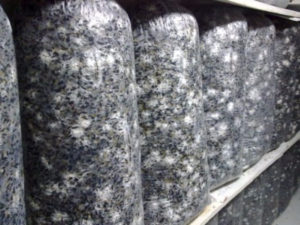
To grow oyster mushrooms in bags, it is imperative that you first disinfect or heat it. An effective way of processing is washing with a solution of bleach.
The optimal volume of the bag should be at least 5 kg.
Further, the planting of oyster mushroom mycelium or the formation of mushroom blocks is as follows:
- There is a layer-by-layer filling of the bag with a substrate and mycelium. For every 5 centimeters of the substrate, there should be about 0.5 cm of mycelium. The top and bottom layers in the bag should be substrate.
- At the end of the filling of the mushroom block, the bag is tightly tied at the neck.
- Then small holes are cut at a distance of 10 cm from each other, with a diameter of no more than 2 cm. The cuts are best done in a checkerboard pattern.
Attention! The planting of mycelium and the cultivation of oyster mushrooms are carried out in separate rooms, since there is a high risk of infection of myceliums.
Video: how to make a perforation of a mushroom block
Further care
In the period from planting to the formation of myceliums, temperature room air should be 18 ° C - 20 ° C. As soon as they are visible first mushroom formations, the temperature is lowered to 13 ° C - 15 ° C. This is the optimum temperature for growing all types of oyster mushrooms.
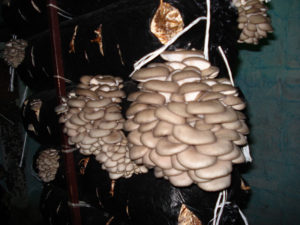
It is very important to maintain humidity air. Watering the substrate is strictly prohibited, since in wet soil the mycelium begins to rot. Even if the myceliums survive, all the mushrooms will hurt, rot and dark spots will begin to appear on them. To achieve optimal humidity in the room, you can hang wet sheets or any other wet cloth. Open containers with water are left near the heating devices, in this way the moisture evaporates faster and saturates the air.
Harvesting
The fruiting period for oyster mushrooms is only 30 - 35 days, which is a very short period.The thing is that these mushrooms have a very high fruiting frequency: every 7 to 9 days. That is, already 9 days after planting the mycelium, you can harvest the first full harvest.
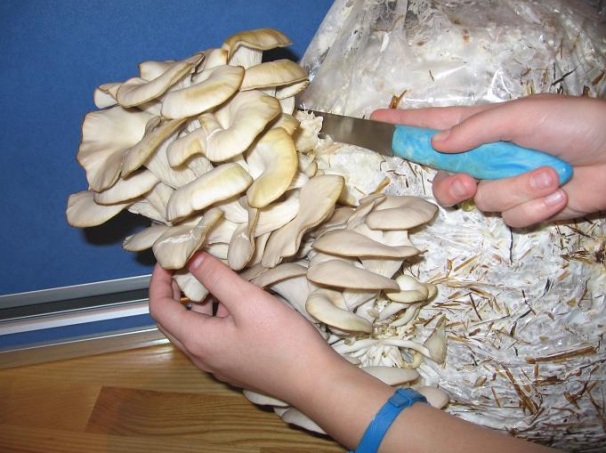
It is customary to cut the mushrooms with a knife carefully so as not to damage the main root attached to the mycelium. When collecting mushrooms, absolutely all fruits cannot be cut from one mycelium. It is necessary to leave 2 - 3 of the smallest mushrooms on the stem, otherwise the mycelium may dry out and stop bearing fruit.
Video: how to properly harvest oyster mushrooms
Important! After the last harvest of mushrooms has been harvested, the substrate and bags must be disposed of. They are not recyclable. The room is well cleaned, ventilated and disinfected. It will be possible to re-breed mushrooms only 2 weeks after all harvesting work.
Video: technology for growing oyster mushrooms
Oyster mushroom diseases and pests: control measures and precautions
It happens that during the fruiting period, the mushrooms begin to hurt. A variety of factors can be the cause of such diseases. If all disinfection work has been carried out in the room, diseases should not disturb the crop.
The main number of fungal diseases lies in the substrate... As a rule, bacteria enter along with wet and rotten straw.
Important! If you are not sure about the quality of the substrate, heat treatedbefore planting the mycelium. It is placed in a large container and poured with boiling water, after which it is boiled for 2 hours, then squeezed and dried.
In a damp substrate, the mushrooms begin to rot, the legs darken and become soft. This disease is called dark rot. If, nevertheless, she overtook the plantings, it is necessary to remove all diseased plants along with the substrate.
Very often oyster mushrooms are attacked mushroom flies, a little less often - ticks. These parasites are also born in the mycelium with excessive humidity and lack of ventilation in the room. Light pits appear on the mushrooms, like small bites. Naturally, such mushrooms must be removed immediately and the room must be disinfected. Do this with smoke bomb, which is left for a day in a hermetically sealed room, and then it is well ventilated.

It is necessary to carefully monitor the state of the mushrooms from the formation of the mycelium to the last fruiting. If one of the myceliums is infected, the entire bag will have to be thrown away, and this will significantly reduce the yield increase.
Summarize. Based on all of the above, it can be understood that growing oyster mushrooms at home is a very simple but laborious process. To do this, you will need to purchase special equipment, prepare the premises and fertile soil, and purchase high-quality mycelium. Further, it all depends on your patience and hard work. With proper care, up to 9 kg of mushrooms can be harvested from one bag. Growing oyster mushrooms is a great option for getting your first experience in mushroom growing.
Video: how to grow oyster mushrooms at home

